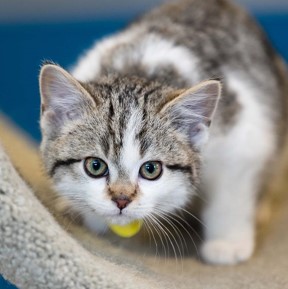Socializing a Fearful Kitten
 A fearful kitten is generally one that has not received a lot of socialization or interaction with people. If a kitten does not have much contact with people during the prime socialization window (between the ages of 2 weeks and 7 weeks), they are likely to be fearful and uncomfortable with new environments, stimuli, and people. Depending on the individual temperament of the kitten, what they have observed from their mother, and how old they are, the kitten may hiss, spit, swat, or attempt to run away. Some fearful kittens learn to trust people quickly, while others can take longer, but they make wonderful companions once provided with the patience, love, and reinforcement they need to truly blossom.
A fearful kitten is generally one that has not received a lot of socialization or interaction with people. If a kitten does not have much contact with people during the prime socialization window (between the ages of 2 weeks and 7 weeks), they are likely to be fearful and uncomfortable with new environments, stimuli, and people. Depending on the individual temperament of the kitten, what they have observed from their mother, and how old they are, the kitten may hiss, spit, swat, or attempt to run away. Some fearful kittens learn to trust people quickly, while others can take longer, but they make wonderful companions once provided with the patience, love, and reinforcement they need to truly blossom.
Setting Your Fearful Kitten Up for Success
Set up a large dog crate in a small room, ideally a bathroom or empty room. This will give them a safe, quiet space while preventing them from darting out the door when you enter or hiding in an unsafe or hard-to-reach location. The crate should be large enough to have their food, water, litter box, a few toys, and a hiding spot where they can be out of view. The hiding space inside the crate could be the carrier you brought the kitten home in, a cat den, a cardboard box, a paper bag, or even a towel clipped diagonally across a corner to create a curtain for them to get behind. This hiding spot will be a safe place for the kitten to avoid interaction and decompress. If you place their carrier in the crate, make sure the carrier door will stay open (you may need to zip tie the door open so it doesn’t swing shut, or you can remove the door completely, if possible). Draping a towel/blanket over the sides of the hiding space can make it cozy and add privacy for your fearful kitten. Even though it is recommended to start the process in a large dog crate, it will be important to kitten-proof the room they are in. If they escape the crate, you want to ensure they will still be safe. You do not want them to be able to crawl under doorways, into furniture or vents, or anywhere that is unsafe or difficult to get them out.
Bringing Home a Fearful Kitten
Kittens respond to consistent positive experiences. You will want to visit them several times a day, keeping sessions short and predictable. Keeping socialization sessions at the same times each day will create a routine that kittens can predict so they can prepare and cope with stress.
Give fearful kittens an initial adjustment period after bringing them home before you begin handling them. These first 24-48 hours will allow them to decompress and adjust to their new environment. During this period, you can refill dry and canned food bowls, refresh water, and clean litter boxes, moving slowly and speaking softly. Do not try to interact with the kitten at this time.
Food will be key to socialization. Providing kittens with food creates an incentive to interact with you and forms a positive association between humans and tasty treats. Be sure to give the kitten access to dry food and water at all times. Each time you visit the room, you can feed small amounts of canned food, staying quietly present from a distance while the kittens eat it. If they’re too scared to eat it while you are there, the act of leaving the food in the kennel will begin to build that positive association.
If they look at you, you can offer slow blinks, indicating in “cat speak” that you mean no harm. Spend time in the room reading a book, watching a tv show, playing games on your phone, etc. The kitten will begin to positively associate you with the food, treats, and respectful interactions. When you are not present in room, leave a TV or radio on at a low volume to help them adjust to human voices and sounds.
Petting and Handling a Fearful Kitten
After the short decompression period, the kittens will most likely still be fearful, but you have already started building trust. Continue to offer canned food each time you come to visit the kennel. You can track your kitten’s progress by where they choose to eat the canned food. Will they only eat the food when you are not present, a couple minutes after you set it down, or immediately after you place food in crate? Over time, as the kitten’s comfort level increases, you can gradually move the food plate closer to you while you sit in the room, until the plate is in your lap and the kittens are comfortable crawling on you to get to it.
Once they are comfortable approaching you at mealtimes, you should pet and handle the kittens for the first time while they are eating so they have an incentive to stay put. If they don’t seem comfortable at first, you can pet them with a paintbrush or toothbrush to create extra distance between the two of you for added comfort. Start petting around the face, chin, and behind the ears, then work up to petting all over. If it is too much for them, stop interacting and end the session on a positive note with an extra treat. If the kitten is accepting the petting with a paint or toothbrush, you can slowly begin gentle petting with your hand. Continue to reward them with canned food or even chicken-flavored baby food. As the kittens become increasingly comfortable, you can look for more relaxed body language, such as their ears no longer being pinned back, their tail moving away from the body instead of wrapped, and slow blinks of their eyes.
Gradually work up to holding them
If you have more than one kitten, picking up and spending time with each kitten individually will be an important step for their socialization with people. When initially picking up your fearful kitten, you will not want to use your bare hands. A fearful kitten may hiss, swat, struggle to escape, or try to bite when picked up. This puts you at risk of being scratched or bitten, which can be extremely painful for you and traumatic for the kitten. Instead, you can use a thick towel or blanket to create a barrier between your hand and a kitten’s sharp claws or teeth. Do not scruff the kitten, as this can be scary and it removes the kitten’s choices, putting them in a stressful state.
You can gently place the blanket or towel over the kitten’s body, sliding one end of the towel or blanket under them and securing the other end before folding the bottom of the towel up. This swaddle is called the ‘burrito method’ since the blanket or towel resembles a burrito. This may be difficult if your kitten is moving and squirming. If the kitten is actively trying to bite through the towel, they are not ready to be picked up and you should continue to offer food to build up a positive association before attempting to hold them again. The kitten will most likely be tense in the burrito initially. You can pet behind the ears, under the chin, or between the eyes. You can talk to the kitten in a soft voice and offer canned food while it is being held. Do not release the kitten until they show any sort of relaxation signal (softening of the eyes, eating offered food, purring when pet, etc.) Releasing the kitten when they are displaying relaxed body language can minimize the reinforcement of distancing-increasing behaviors, such as struggling to escape, hissing, or pinning their ears back.
If your kitten has relaxed and settled several times in the burrito swaddle, you can move to the ‘taco swaddle.’ The taco swaddle uses the bed or blanket the kitten is already on and requires less restraint. When the kitten is on a cat bed or blanket, you can fold over the sides and move them into your lap or another location. This is for kittens who are not going to struggle to get out of the hold. After multiple sessions of a kitten relaxing in the taco hold, remaining soft, and accepting petting, you may pick up and handle your kitten with your hands. Continue to read the kitten’s body language. If they appear tense or show signs of stress, it is better to use a towel or blanket to aid pick-up than risk a bite or scratch that would potentially require medical treatment. After every handling session, you can offer a bit of canned food or even chicken-flavored baby food to the kitten as a reward for accepting petting. This will continue to positively associate the petting and handling with tasty treats.
Playing with a Fearful Kitten
Play is a great way to develop your bond with your kitten, as well as provide much-needed exercise and enrichment. Always have toys available for your kitten, such as glitter balls, crinkle toys, or even treat-dispensing puzzles. You can bring additional interactive toys for you and the kitten to play with together when you are in the room. This could be a cat ball tower, a tunnel, or a wand toy. You do not want to stick any toy in the kitten’s space, but instead lure them out. A wand toy is an especially great tool because it activates their innate prey drive and is highly enticing to the kitten, but still allows for some distance between the two of you for a stress-free interaction. You can jerk the wand toy around in tiny motions to mimic prey like mice or birds, alternating between wiggling it on the floor and up in the air to see which is most interesting to your kitten. Be sure to start and stop the movement often, as they are drawn to the quick and unpredictable movements of their prey; constantly whipping the ribbon or toy around nonstop can become off-putting and overwhelming, causing them to retreat. When the kitten gains more confidence, they will come out of the hiding spot and engage with the toy. After each play session, you can reward them with a tasty treat!
Breaking Free of the Crate
When kittens are displaying relaxed body language, choose to approach you, and you can handle them without a towel, then they are ready to explore the full room. This is another chance to double-check for hiding spots and put away any items you would not want a kitten to get into. The crate can be propped open so the kitten still has access to their familiar safe spot. They may initially hide as the additional space and new objects and smells can be overwhelming. That is okay! They are still learning that people are safe and how to cope with change. You can spend time with them in the room, offer canned food, and have play sessions until they are displaying more relaxed body language. In this larger space, you can introduce new items like cat scratchers, cat towers, and larger toys that would not fit inside the crate.
When the fearful kitten is ready for the room, they also are ready to meet new people. The goal is to socialize the kitten so they are comfortable around all people and possibly pets. As long as the kittens are healthy and have had their first round of vaccinations, it is safe to introduce them to adult strangers and potentially children. The kitten may hide when unfamiliar people enter the room; it should always be the kitten’s choice to approach and interact with new people. Have visitors offer them canned food or a treat, or possibly initiate a play session. You want the kitten to have as many positive experiences with new people as possible. It is important that they consistently display relaxed body language before meeting new animals. If introducing a fearful kitten to other animals in the home, please see our resources on cat-to-cat or cat-to-dog introductions.
It is important to remember that kittens are individuals – some take longer than others to display relaxed body language, and some may never feel completely comfortable with certain people. It is a special experience to build a relationship and bond with a fearful kitten – they are so worth the wait!

